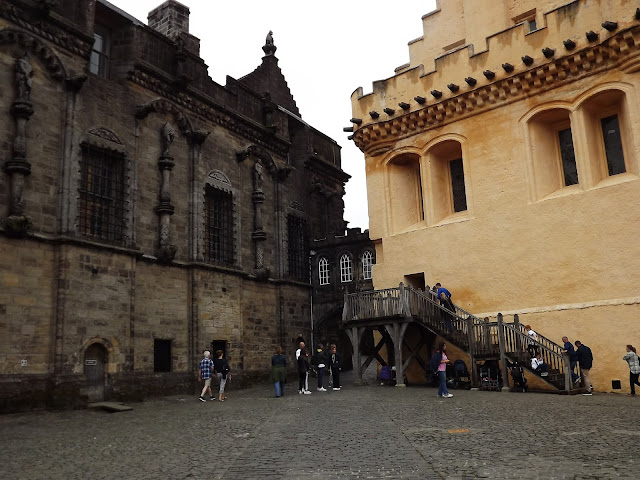A Palace for King's and Queen's
Stirling Caste, a place full of history, it has seen King’s and Queen’s over the time. English ownership but luckily for a lot of time Scottish ownership as well. By this, the history of Stirling Castle is a very bloody at parts.In the time
between 1107 till 1115 the castle was first mentioned in a written record when
Alexander I endowed a chapel. From then on until the Unions of the Crowns in
1603, almost every Scottish monarch had either lived or been crowned or died at
Stirling Castle.
In 1174 the Castle got handed to Henry II of England as a part of the ransom for William the Lion. After the Scottish garrison fled the castle in 1296, the gatekeeper handed it to Edward I of England.
After the defeat of the English army by William Wallace and Andrew Moray at the Battle of Stirling Bridge (1297), the Scots retook the Castle. Just seven years later in 1304 the Garrison at the Castle surrendered to the English after Edward I of England besieged the Scots using siege engines to force the surrender. Ten years later, after Robert Bruce’s victory at Bannockburn, the English surrendered the castle and once more it has been in the hands of Scotland.
All this
happened before the oldest part of the now surviving castle, the North Gate, has
been built in 1381.
James III’s
queen Margaret of Denmark took her last breath at Stirling Castle, in 1496.
Beginning
1500s James IV ordered the forework to be build and in 1503 his Great Hall, the
largest in Scotland, has been completed. Maybe one of the biggest fools of that
time John Damian, attempted to fly from the Castles walls with feathered wings
in 1507. He ended up with a few broken bones but his life in the dunghill
below.
In 1513
after a long time finally another Scottish King was crowned in the chapel royal
of that time. It was James V at the age of only 17 months.
27 years
later, the King started building his magnificent royal palace. It took nine
years to build the French Spur, designed to defend the castle’s vulnerable
eastern flank.
After being
crowned Mary Queen of Scots in the Chapel Royal in 1543, following the death of
her father, Mary spent years in France before returning to Scotland. When
finally staying at Stirling again, in 1561 a candle set fire to her bed, while
she has been sleeping in it.
Years after
that the Baptism of future King James VI took place in the Chapel Royal in 1566.
In the period from 1570 till 1579 James VI kept on living in Stirling Castle
and enjoyed his royal education there. In 1594, during his reign he build the
Chapel Royal for the baptism of his son Henry.
23 years
later over £ 13,000 were spent on works in
anticipation of a visit by James VI, who at that point in time has already been
crowned James I of England. In 1650 Charles II paid Stirling Castle a visit.
Just one year after that the Parliamentarian army under Lieutenant General
George Monck took the castle from royalists.
The Grand
Battery at Stirling Cast was built during the first Jacobite rising in 1689. And
from 1708 – 1714 the outer defences followed.
During the
last Jacobite rising in 1746, the Bonnie Prince unsuccessfully laid siege to
Stirling Castle. After that the castle got mostly abandoned.
In 1777 the Stirling Heads, carved wooden roundels dating from c 1530, got removed after a ceiling collapsed in the palace. One year later Robert Burns visited the castle and scratched his anti-Hanoverian “Stirling Lines” on the window at Wingate’s Inn afterwards.
The
“Stirling Lines” by Robert Burns:
During
Britain’s war against the revolutionary France 1790 – 1799 the Castle became army
barracks. Just 50 years later Queen Victoria became the first reigning monarch
to visit Stirling Castle in almost 200 years. The next royal visit would be her
Majesty Queen Elizabeth II in 2007 for her 60th anniversary as Colonel-in-Chief of the Argyll and Sutherland
Highlanders.
In the
following years it served as a military depot of Argyll and Seaforth
Highlanders and got ceased to be a military depot.
Take one of the guided tours through the Castle and make sure to plan in some time for exploring on your own as well.
For more of Stirlings History check out the enclosed blog article:
History of Stirling









Comments
Post a Comment